
Quantum Efficiency Tester
PL/EL Integrated System
PV-Reflectumeter
3D Confocal Microscope
In-Line Four Point Probe Tester
Four Point Probe Tester
In-Line Thin Film Thickness Tester
Raman Spectrometer
FTIR Spectrometer
Spectrophotometer
Automatic Spectroscopic Ellipsometer
Contact Resistance Tester
Ultra depth of field 3D microscope
Auto Visual Tester
VMM PV Vision Measuring Machine
Solar Cell Horizontal Tensile Tester
Steady State Solar Simulator for Solar Cell
Solar Cell UV Aging Test Chamber
Solar Cell Comprehensive Tensile Tester
Visual Inspection Tester
Wet Leakage Current Tester
PV Module EL Tester
PV Module UV Preconditioning Chamber
Steady State Solar Simulator for PV Module
Current Continuous Monitor
Potential Induced Degradation Test
Bypass Diode Tester
LeTID Test System
Reverse Current Overload Tester
Impulse Voltage Tester
Hipot Insulation Tester
Ground Continuity Tester
Hipot Insulation Ground Tester
Damp Heat Test Chamber
Humidity Freeze Test
Thermal Cycle Test Chamber
Dynamic Mechanical Load Tester
Static Mechanical Load Tester
Hail Impact Tester
Robustness of Termination Tester
Module Breakage Tester
Cut Susceptibility Tester
Peel Shear Strength Tester
Universal Testing Machine (Single-arm)
Universal Testing Machine (Double-arm)
Glass Transmittance Tester
Acetic Acid Test Chamber
EVA Degree of Crosslinking Test System
Junction Box Comprehensive Tester
Drop ball tester
Semi-automatic scanning four-probe tester
Stylus Profilometer
Maximum Power Point Tracker
Perovskite Glass Transmittance Tester
Perovskite P1 Laser Scribing Multifunctional Testing Machine
Perovskite Online PL Tester
Perovskite Online Sheet Resistance Tester
Online Perovskite Film Thickness Tester
Perovskite Process Inspection Workstation
Portable IV Curve Tester
Portable EL Tester
Portable Thermal Imaging Tester
Solar Module Multi-Channel Testing System
PV Inverter Power Quality Tester
Drone EL Tester
IV Tester
IVEL Cell Sorting Machine
Research on the sealing loss control method in the manufacturing process of photovoltaic modules
Date : 2025-07-30Views : 125
“Low cost, high efficiency and long life” is the pursuit of PV module manufacturing, and controlling and reducing module power loss is the key.
The power loss of PV modules mainly includes two parts: encapsulation loss and operation loss. Encapsulation loss refers to the power loss caused by material characteristics and process problems during the manufacturing process of the module, which is usually expressed in terms of the power conversion rate (CTM) or power loss rate (PL). Ideally, the output power of a module should be equal to the sum of the power of all cells, but the actual power is often lower than the theoretical value, and the CTM value is usually between 96% and 97%.
Module Design Principles
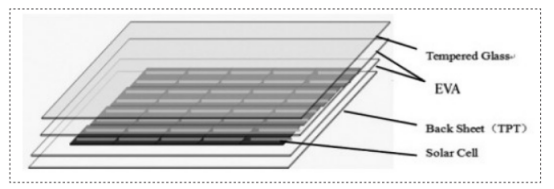
Module encapsulation structure diagram
Typical layered structure of crystalline silicon photovoltaic module, including tempered glass, EVA adhesive film, battery string (cell, interconnecting strip, converging strip), EVA adhesive film, backsheet, etc. from top to bottom.
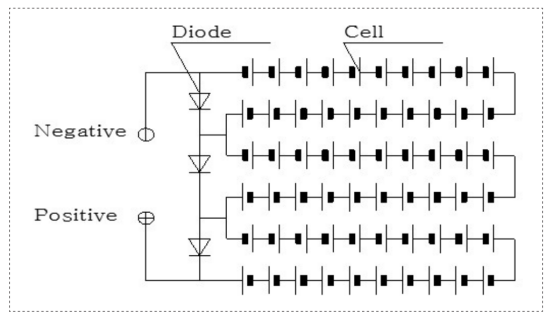
Component electrical schematic
Through the diode and battery positive and negative connection schematic, explain the series path of current in the module and the principle of electrical work, and provide theoretical basis for the analysis of electrical loss (such as series resistance, mismatch loss).
Optical loss analysis and control methods
1.Gaining effect of encapsulation material on optics
The optical loss of PV module mainly originates from the absorption and reflection of incident light by encapsulation material. Research shows that ultra-white embossed tempered glass can improve the transmission rate of light in the wavelength range of 300~1200nm due to its low iron content and surface embossed structure, which improves the short-circuit current of the encapsulated module by 3~4%.
2. Application of Improved Encapsulation Materials
Coated Glass: Adding nano-SiO₂ reflection-reducing film on the surface of ordinary PV glass, the light transmittance is increased from 91.5% to 94%, and the power output of the module is increased by 1.5~2%.
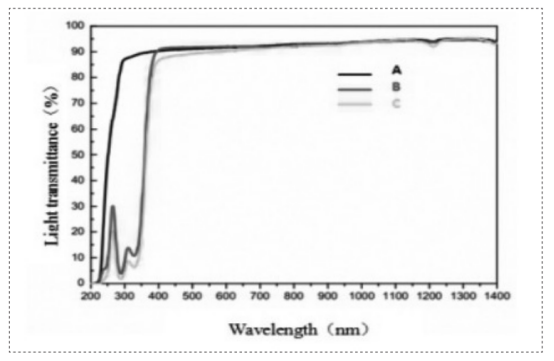
Different EVA transmittance
EVA film optimization: Low cut-off EVA (cut-off wavelength 280nm) can better utilize the light energy in the 280~380nm band than high cut-off EVA (380nm), which can enhance the module power by about 0.8% when used with high square resistance cells.
Backsheet material: High reflectivity white backsheet can reflect up to 80% of the light above 500nm, which improves efficiency by 1~2% compared with black or transparent backsheets.
Electrical loss analysis and control methods
1. Main sources of electrical loss

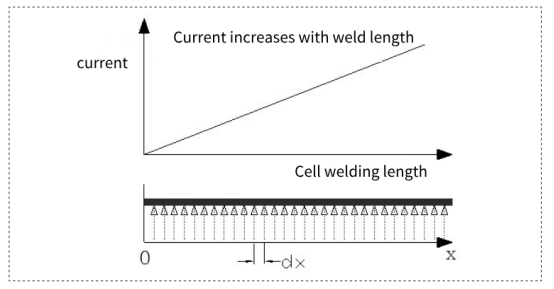
Interconnecting strip welding section current schematic
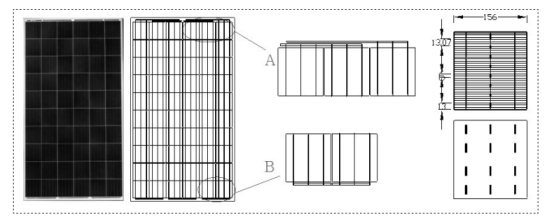
Example of polycrystalline module connected with cell and converging strip schematic diagram
Electrical losses mainly include battery mismatch loss, interconnection strip resistance loss, busbar resistance loss and junction box resistance loss. Research shows that:
Interconnection strip resistance loss accounts for the largest proportion, more than 60%;
Battery mismatch loss and sink band resistance loss each account for about 15%;
Junction box and contact resistance loss accounts for less than 1%.
2. Key measures to reduce electrical losses
Optimized interconnect strip design: Through front-side silver plating and calendered longitudinal structure, part of the light can be reflected back to the module, and the power can be increased by nearly 2%.
Improve battery staging process: Dual staging method of power and current is adopted to reduce battery series mismatch.
Reducing the resistance of the converging strip: Optimizing the material and welding process of the converging strip to reduce the current transmission loss.
Power attenuation and control during operation
The power attenuation of PV modules during operation is divided into initial photoluminescence attenuation (LID) and aging attenuation:
Initial photoluminescence attenuation: It is mainly caused by the boron-oxygen complex in P-type crystalline silicon, which can be mitigated by pre-lighting treatment.
Aging attenuation: related to the degradation of encapsulation materials, the use of UV-resistant materials can slow down the rate of attenuation.

































































